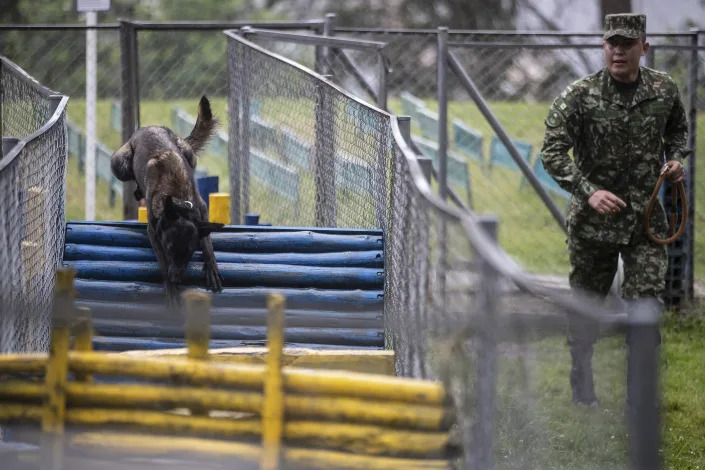Kevin Keane - BBC Scotland's environment correspondent
Thu, June 22, 2023

Nikki Yoxall has a small livestock herd at Glass in Aberdeenshire
Nikki Yoxall isn't your conventional farmer.
She describes herself as an agro-ecological grazier. She doesn't own a tractor, has no barns or sheds, and she grows no crops.
Instead, her herd of beef cattle is kept continually on the move across a range of pastures at Glass in Aberdeenshire.
And she receives no direct government subsidies for food production.
Nikki wants to see the system changed so that the focus is on helping the environment.
But that puts her in opposition with the views of many other farmers. They have been urging the Scottish government to retain the principle of direct financial support, topped up with funding for environmental measures.

The livestock are grazing in much longer grass than you would expect
Nikki makes a profit because her farming method is low input, which means that the cost of keeping the livestock is significantly lower than on conventional farms.
The animals are outside all year round and are moved daily, either to another field or to a different section of the same field.
This allows time for the ground to recover and become a haven for wildlife before the animals return to that patch, often months later.
Ground nesting birds like skylarks and meadow pipits have been spotted nesting in the same fields because there's enough time for them to raise their broods.
Although her herd contains only 30 animals at present, Nikki insists the grazing system she practices is replicable at scale with some already doing it with up to 180 animals.
The average herd size in Scotland is around 200 animals and some would regard Nikki's approach as "hobby farming", although she would take exception to that description.
Scottish agriculture is at an important crossroads as a result of Brexit.
The EU Common Agricultural Policy is being replaced with a subsidy system which will be designed and administered in Scotland.

Abundant wildflowers in the ungrazed area contrast with the recently grazed patch
Some environmentalists are concerned that retaining too much of the status quo will not provide the type of transformational change that is needed.
Nikki wants to tip the balance in favour of environmental improvements, with three quarters of payments going towards measures which improve nature and tackle climate change.
The rest would be direct payments to farmers for food production.
She said: "I'm not sure that we're heading in a transformative direction and there are various challenges around the mechanics of policy which make that really difficult.
"What we need to do is put very strict conditions on that funding to make sure that nature and climate are prioritised."
But many farmers recoil at the idea of attaching more conditions to farming.

Gary Christie operates a more traditional farm which relies on subsidies
The last few years have been a rollercoaster for them, with the war in Ukraine pushing up fertiliser and energy prices.
And they warn that if there is too much burden placed on them, their businesses will collapse.
Gary Christie farms just five miles away from Nikki.
He doesn't think his business could have survived without subsidies.
Gary operates a more traditional farm with a much larger herd and heftier Simmental cows from the continent.
They are only pasture-fed from around May to October, by which time there is little grass left. They then have to be housed indoors.
It's a more expensive way to produce the beef, but it means he can put more meat into the market.

Simmental are a continental breed which produce much more meat
Along with the farming union NFU Scotland, Gary is urging ministers to be careful about attaching too many expensive environmental conditions to subsidies.
They say this would make some businesses unprofitable. Instead, they want 80% of the funding to go directly to farmers for supporting food production.
Gary said: "If a beef farm is profitable it'll deliver on food, it'll deliver on climate and it'll deliver in nature.
"If we're in the red, we can't go green."
Gary acknowledges that there is probably more that farmers can do to protect and enhance nature - but says ministers need to be clear on what they expect.
He says the support from government is "vital to keep us afloat" and producing affordable food to feed the nation.
One thing all farmers agree on is the urgent need for clarity over future farming policy, which has been in the making for many years.
Agriculture requires investing in stock which might not deliver a return for three years. Not knowing what support will be available at the point of sale is troubling to many.
Farming leaders hope ministers will use the annual Royal Highland Show at Ingliston to offer some clarity about the way forward.




























